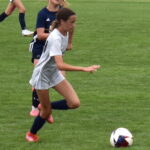What college coaches want in a player
 College coaches will again crowd the sidelines at this year’s Jefferson Cup boys and girls showcase tournaments in March. And if you’re a potential recruit with college soccer ambitions, know this: in the eyes of a college coach, the little things matter.
College coaches will again crowd the sidelines at this year’s Jefferson Cup boys and girls showcase tournaments in March. And if you’re a potential recruit with college soccer ambitions, know this: in the eyes of a college coach, the little things matter.
I recently walked the sidelines at the CCL Showcase tournament at the excellent River City Soccer Complex in Midlothian, Va., to talk with coaches of men’s and women’s college programs. Initially cautious when a stranger with a recording device walks up to them, as a group they opened up when I told them I wanted to give them a chance to educate young players on the big – and little – things they look for in a player.
Some of the things I learned:
Character matters. Nearly every coach with whom I spoke started the conversation by saying they are looking for players who are “coachable.” When viewing a game, college coaches pay particular attention to how a player receives instruction from his coach. A player’s coachability stands out quickly, they said.
+Read: Poaching vs. Coaching: Can you tell the difference?
“First, we’re looking for character,” said Chris Bergmann, head women’s coach at Virginia Military Institute. “Character is refined through work ethic, how you treat the authority figures on the field, through how you treat your teammates. And then, ultimately, you see it through adversity, when things don’t go your way.”
“It’s important,” said Virginia Wesleyan women’s assistant coach Matt Gill. “We want to know how you’re going to respond to a little criticism if you’re on the field and we’re trying to critique you a little bit. Basically, how coachable are you?”
Several of the coaches were specific in what they watch during a game. One women’s coach told me that a player who “rolls her eyes” when a coach gives an instruction is a warning sign. Another said how players respond to a teammate’s mistake could be an indicator if they are an asset in the locker room, or a potential problem.
“We’re looking for technical skill and speed of play, but we’re also looking for other things like how you’re interacting with your teammates, what’s your work rate like after you turn the ball over, things like that,” one coach told me.
“We’re not looking to bring in any drama.”
Coaches are even paying attention when the game is over.
+Read: How to be intentional with your college commitment
“Attitude is huge,” Averett University assistant men’s coach Nick Carter said. “You can see who is coachable straight away just by how they interact with the coach, and even how they interact with their parents after the games. “
Said one women’s coach: “Our jobs are based on decisions made by 18- to 22-year-old young adults. Everyone makes mistakes, but if you can minimize those mistakes, it makes everyone’s lives easier.”
Technique matters. In a recent column I noted how youth coaches are sometimes failing their players by not correcting the little mistakes. My conversations with college coaches confirmed my concerns.
At the college level, simply trapping a ball well isn’t good enough. The speed of play and the physical nature of the game demands better.
“If your touch gets away from you and it takes a couple of steps to get it, it’s going to slow the pace down,” said VMI’s Bergmann “Tempo is extremely important to us. So we’re look for how fast can a player move the ball and, on the other side if it, how fast can a player move off the ball. After a pass, do you watch it, or do you move?”
In coach-speak, it’s described as technical efficiency. How much time it takes from when a player traps the ball to the time she sets up the pass, shot or dribble. It also means using the first touch to tell the ball where to go, rather than simply reacting to wherever the ball happens to go.
Said another coach: “We’re looking at players who have their head up, see the play, and technically make the first touch in the right direction.”
Several women’s coaches with whom I have spoken over the years have noted the importance of bringing the ball out of the air and down to the ground to initiate an attack or regain possession. The skill is sometimes lacking in girls soccer, as players tend to head or kick the ball away first time instead.
And defenders, take note: if you can’t pass, you may have trouble playing.
At Virginia Wesleyan, Gill said his team plays with three defenders in a 3-4-1-2 formation. His defenders need to be able to defend well in 1 vs. 1 situations and be able to generate an attack with the right pass.
“Possession out of the back is huge with the three-back system,” he said. “If you lose it deep in your defensive third then you’ll be countered quickly. So we’re looking for players with composure.”
Being physical matters. Many college games more closely resemble Greco-Roman wrestling matches than soccer matches. That’s unfortunate, but it’s also reality. Especially at the Division I level, where the pace and physical nature of the game demands players who can keep up.
“It’s great if you’re a technical player, but if you can’t handle the physical demands of the game at the end of the day it’s going to be really hard, especially at the Division I level,“ said VMI women’s assistant coach Chris Haught-Thompson.
And while size matters, the good news for smaller players is that coaches look for more than height and muscle. In the end, it comes down to quick thinking and body leverage to win the area around you.
“If you win the space, you’ll win the ball,” Haught-Thompson observed. “Do you have the strength, the leverage, the smarts to win the space? It’s the ability to read the game well and getting to the spot before a bigger player who will likely win the 50-50 ball.
“If you get there first, it doesn’t really matter how big you are. You need to use the tools that you have to make yourself successful.”
I asked one men’s college goalkeeper coach if the European trend of goalkeepers being six-foot-four or taller means that smaller goalkeepers don’t have a chance.
“You don’t have to be six-four,” he said. “I look for command in the box. The ability to judge early where the ball is going to be, and the ability to interact with the defenders in front of him.”
He said good goalkeepers have the defenders in front organized to keep the shot from occurring.
“If you can keep the ball out of the net, that’s more important than just being six-four.”
Multi-dimensional matters. The evolution of college soccer in recent years has been significant. Teams are trying new systems of play, from the English 4-4-2 and the Dutch 4-3-3 to variations on those formation, such as Virginia Wesleyan’s 3-4-1-2.
Which is why every coach made it clear that players need to be multi-functional.
It also means that a player’s position on his or her club team may or may not be the same position they play in college.
“We’re not necessarily recruiting for positions,” Bergmann said. “We’re looking for the assets and the tools a player has and if that player can fit in our system.”
Players who typically play as a wing or wide midfielder on a club team my fit the role of a wide outside back in college, coaches said. Another example: since passing out of the back has become an important skill set, a good holding midfielder at the club level may transition to center back in college.
“Other than goalkeeping, we’re not looking for position-specific players,” said Bridgewater College women’s coach Mike Van Horn. “We’re looking for a good soccer player. If she has the athletic ability, the technical ability and can make good decisions, then hopefully she can move around to different places on the field.”
“We look for complete players,” Carter said. “Sure, sometimes you see kids and it’s obvious they have a certain position. But if you have the confidence to go one on one offensively, and handle one on one defensively, then you’ll fit in anywhere on the pitch.”
SOCCERWIRE MARKETPLACE
- Start the Season Strong at Loudoun Premier Cup!
- 50th Annual Rael Vodicka Memorial Tournament
- Soccer Marketing Internships at The St. James FC
- Job Opening: The St. James FC Goalkeeper Academy Coach
- Full-Time Director of Goalkeeping for The St. James FC
- visitRaleigh.com Showcase Series 2025, hosted by NCFC Youth
- Join Official Elite Summer Soccer Camps with Europe’s Top Pro Clubs!
- OFFICIAL BAYERN MUNICH SUMMER CAMPS U.S.
- OFFICIAL FC BARCELONA CAMPS U.S.
- The Cup San Diego - Hosted by Legends FC











